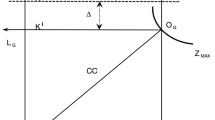Abstract
This paper provides a model of the transition from hegemonic trade to contemporary (or fair) trade. Hegemonic trade is an instance of the two player game called Bully (Poundstone 1992) and Called Bluff (Snyder and Diesing 1977); contemporary trade is an instance of Prisoner's Dilemma (Krugman and Obstfeld 1991). In this paper, I show that a nation under the thumb of a hegemon, called the conciliatory nation, can induce fair trade. Further, I show that to induce fair trade, the conciliatory nation must not be timied.
Similar content being viewed by others
References
Axelrod, Robert: 1984,The Evolution of Cooperation, Basic Books, New York.
Axelrod, Robert and D. Dion: 1988, ‘The Further Evolution of Cooperation’,Science 242:4884, pp. 1385–90.
Conybeare, John A. C.: 1984, ‘Public Goods, Prisoner's Dilemmas and the International Political Economy’,International Studies Quarterly 28, 5–22.
Dacey, Raymond and Norman Pendegraft: 1990, ‘The Impact of Election Frequency and Crises Upon the Arms Race’,International Interactions 15, 331–43. (Reprinted in Frank C. Zagare (ed.): 1990,Modeling International Conflict, Gordon and Breach Science Publishers, New York.)
Dacey, Raymond and Norman Pendegraft: 1988, ‘The Optimality of Tit-for-Tat’,International Interactions 15, 45–64.
Davis, Lance and Robert A. Huttenback: 1986,Mammon and the Pursuit of Empire: The Political Economy of British Imperialism, 1860–1912, Cambridge University Press, Cambridge, UK.
Gilpin, Robert: 1987,The Political Economy of International Relations, Princeton University Press, Princeton, NJ.
Griffin, Keith: 1979, ‘Underdevelopment in History, in Charles K. Wilber (ed.),The Political Economy of Development and Underdevelopment, Random House, New York, pp. 77–89.
Griffin, Keith: 1969,Underdevelopment in Spanish America. MIT Press, Cambridge, MA.
Keohane, Robert O.: 1984,After Hegemony, Princeton University Press, Princeton, NJ.
Krugman, Paul R. and Maurice Obstfeld: 1991,International Economics, Harper Collins Publishers, New York.
Kugler, Jacek and Frank Zagare: 1990, ‘The Long-term Stability of Deterrence’,International Interactions 15, 255–78. (Reprinted in Frank Zagare (ed.): 1990,Modeling International Conflict, Gordon & Breach Science Publishers, New York.)
Leng, Russell J.: 1993, ‘Reciprocating Influence Strategies in Interstate Crisis Bargaining’,Journal of Conflict Resolution 37, 3–41.
Poundstone, William: 1992,Prisoner's Dilemma, Doubleday, New York.
Snyder, Glenn H. and Paul Diesing: 1977,Conflict Among Nations: Bargaining, Decision Making, and System Structure in International Crises, Princeton University Press, Princeton, NJ.
Author information
Authors and Affiliations
Rights and permissions
About this article
Cite this article
Dacey, R. Inducing fair trade out of hegemonic trade. Synthese 100, 497–504 (1994). https://doi.org/10.1007/BF01063913
Issue Date:
DOI: https://doi.org/10.1007/BF01063913




